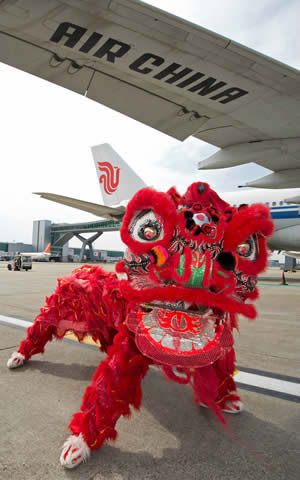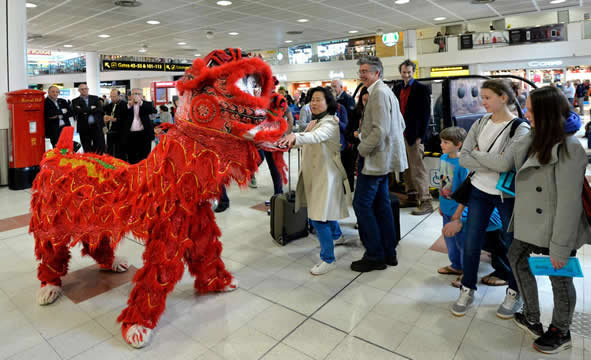Below you will find some of the details of the dance itself and the significance of some of the movements.
The lion dance can be performed in a number of different ways but each version is based on a several basic parts or sequences.
The sequences can be listed as:
- A sleeping sequence
- An opening sequence
- A playing sequence
- A searching sequence
- A fighting sequence
- An eating sequence
- A closing sequence
- A final sleeping sequence
Any given dance may vary by including or excluding one or more of the sequences but there will always be an opening sequence, an eating sequence and a closing sequence.
The sleeping sequence has three sections: sleep, waking up, and cleaning. The lion cleans each part of itself before shaking its head three times and rising. This whole sequence represents the awakening of the spirit, getting rid of the old and renewal. Having completed this section the lion embodies a state of holy purification.

During the opening sequence the lion bows 3 times as a sign of reverence. The 3 bows can be traced back to the three passes of the twelve animals in the ancient custom of cleansing the emperor's palace. If the lion has to enter a building it is usual for the lion to bow 3 times before any alter or shrine that may be present.
The playing sequence is fairly freeform and it is during this sequence that the best skills of the dancers can be demonstrated. This might involve climbing or balancing movements or playing with a ball which represents a pearl.
After playing the lion starts to search for food. This part can be quite demanding because the food is often placed in a difficult to reach location and it represents a sort of test of strength.
It is not at all uncommon for the dancers to have to climb over obstacles such as benches or poles to reach to food. In fact, tremendous athletic and acrobatic agility is required for this sequence. It is usual for the lion to jump between small platforms situated on the top of poles high above the ground and for the person playing the head to be carried by or balance on the person playing the tail.
If there is more than one lion present it would be natural for a fight to break out between the two lions, and that is what happens.
The food is usually in the form of green vegetables such as lettuce that are hanging on the end of a string. The green vegetables (or 'choi cheng' in Cantonese) are a symbol of wealth and good luck. This is a fun part because the lion, or rather the dancer in the head, takes the greens into his mouth where he shreds it. The greens are then shredded and 'spat' over the audience. It is also the part where the dance troupe gets its reward because included with the greens is a lucky red packet containing money.
It is also believed that during the Ching Dynasty underground fighters whose aim it was to restore the Ming Dynasty used this method to covertly pass messages to each other.
In the closing sequence the lion cleans himself again before bowing 3 times.
Having finished his task the lion returns to sleep.
